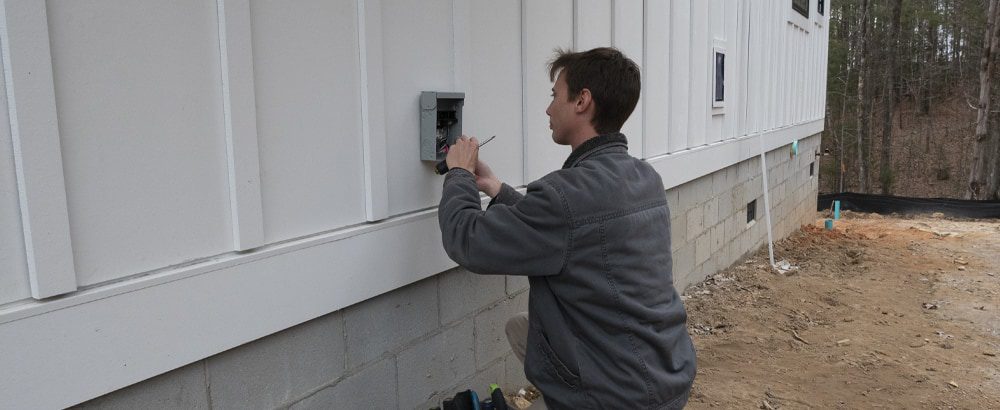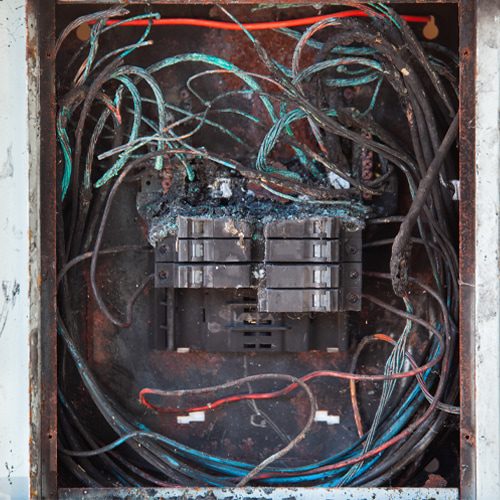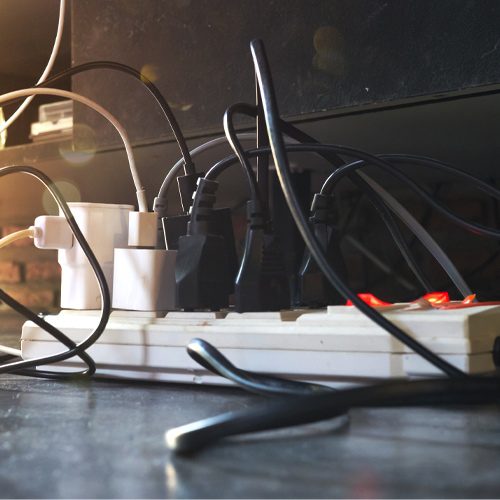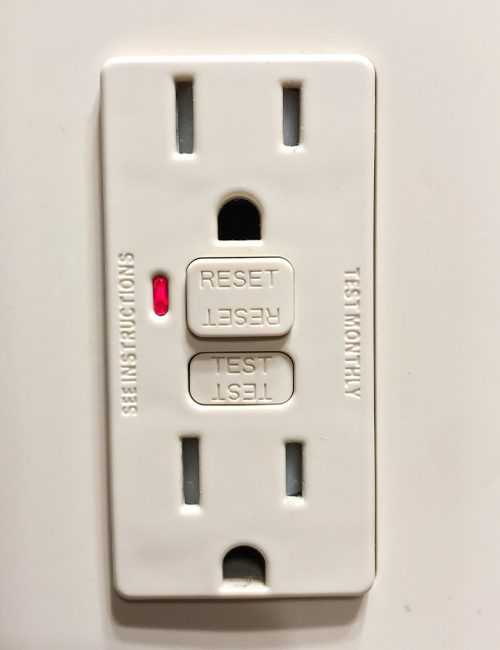2020 Home Electrical Inspection Checklist
Prevent expensive electrical headaches by keeping an eye out for these early warning signs. This quick electrical checklist will give you a few pointers on catching problems while they’re small — and when it’s time for a professional home electrical inspection.
Garage Electrical Inspection Checklist
For some homes, your electrical panel will be located in the garage. Because it is often exposed to weather, your garage could be at risk for problems related to moisture and heat that affect electrical service panels.
- Rusty electrical panels
- Frequently tripped circuit breakers
- Older electrical system
Rusty Electrical Service Panels
If your fuse box is showing signs of moisture, mold, and/or rust, there’s a good chance that your wiring connections could be deteriorating. You should call your electrician to have your service panel or wires replaced before you’re left in the dark.
If your panel has any branding on it from the Federal Pacific Electric Company, it needs to be replaced. These panels are a known fire hazard and can not be rendered perfectly safe.
Frequently Tripped Circuit Breakers
Another good sign that an electrical problem is on the horizon is if your circuit breakers are tripping frequently. If you brace yourself when turning on your favorite kitchen appliance because you know the breaker might trip, chances are you’ll need to call an electrician.
A licensed electrician will be able to find the issue and install a separate circuit to accommodate your appliances if necessary.
The Kitchen Electrical Inspection Checklist
It is often believed that the kitchen is the heart of the home. It’s also the place where most of your major appliances will be used. Therefore, it’s important to inspect your kitchen carefully for potential electrical hazards.
- GFCI outlets
- Dead appliances
- Shocking appliances
GFCI Outlets
Modern homes are now being equipped with GFCI outlets in rooms where a large number of appliances are expected, like kitchens, bathrooms, and laundry rooms. If you’re unfamiliar with GFCI outlets, these are the outlets that have one or two buttons in between the plugs that can pop out from time to time. A GFCI outlet is designed to trip whenever there’s a risk for electric shock.
Nowadays, GFCI outlets are required throughout your home to ensure it’s up to code. If you don’t have GFCI outlets around your kitchen, you’ll need to call an electrician to update your home’s outlets. Also, you may have noticed this happening whenever you plug in a certain hair dryer or toaster oven. When this happens too often, it is time to have them replaced.
Dead Appliances
A good sign that you may need electrical work is when your appliances aren’t working at full capacity. It’s not uncommon to find that your food spoils slightly faster than expected, or your electric stove takes a while to “warm up”. If several appliances aren’t working at full-strength, you may want to call an electrician to diagnose the problem.
Shocking Appliances
When it comes to appliances, the only thing shocking should be the sticker price. If ever you are shocked by any of your home’s appliances, call an electrician immediately. Let a professional determine if there’s an underlying electrical problem that needs to be addressed or if the appliance just needs to be replaced.
Dining & Living Room Electrical Inspection Checklist
These rooms often have high traffic and lots of electronics plugged into your home’s electrical system. It’s not uncommon, especially in older homes, to notice flickering or dim lights when turning on your TV or other large electronics. Pay attention to these points when inspecting your living areas for electrical safety.
- Dim lights
- Flickering lights
- Excessive cords
- Strange smells
Dim Lights
Have you ever turned on a light and noticed that it’s not as bright as it usually is? Do your lights dim periodically on their own, or when you turn on other lights and appliances? Dimming lights could mean that there are too many devices sharing that circuit. This is commonly handled by adding new dedicated lighting circuits or updating your electrical panel.
Flickering Lights
Flickering lights can be related to one of several common electrical issues. When your lights flicker or take some time to turn on, it could be an indication of a short in your electrical system.
It’s important that you don’t attempt to diagnose or fix this problem yourself, for your own safety. Call a licensed professional to inspect your light fixtures and electrical service panel to identify and correct the problem.
Excessive Cords
The living room is often the heart of the home, where the family comes together for entertainment. If you find that your family is used to navigating through cords in your living room like tripwires, it may be time to call your electrician and inquire about installing more outlets in the room.
It’s not uncommon for homeowners to use extension cords or surge protectors to power a TV, DVD player, cable box, sound bar, and other electronics together. However, running cords across the room, even under rugs or furniture, poses a major threat to safety. Tripping over these cords could cause injury. Accidentally ripping them from outlets could damage the electronic or, even worse, the outlet itself.
According to the ESFI, nearly 3,300 home fires can be sourced to extension cords each year. Using extension cords properly and safely could prevent a disaster in your home. Never plug extension cords into each other to extend reach. Just find and purchase a longer extension cord to better suit your needs. Inspect your extension cords for damage before using them. Always use surge protectors when powering larger appliances to avoid outages and sparks.
Call an electrician to install more outlets in your home to accommodate your home’s electronics.
Strange Smells
More than 51,000 house fires are caused by electrical problems each year, causing at least 500 deaths, 1,400 injuries, and over $1.3 billion in property damages. Because these fires often start at the outlet source or within the walls, a lot of homeowners cite never knowing about an underlying electrical problem until it was too late.
One way to keep an eye out for potential electrical fires is to be aware of any strange smells. Pay attention to anything that smells like burning plastic fish, rotten eggs, dead animals, or even urine through your home as this could be a sign of burning wires or fixtures. If you notice any of the plates around switches or outlets are charred, yellowing, or showing signs of abnormal discoloration, turn off the circuit breaker to that area and call an electrician immediately for an electrical safety inspection. It’s better to be proactive when you suspect potentially harmful electrical issues than to put it off for any reason. Some electricians even have 24/7 emergency services to help prevent electrical disasters.
Bedroom Electrical Inspection Checklist
Our bedrooms serve as our own personal sanctuaries where we can retreat to after a long day. With as much time as we spend in our bedrooms, it’s important to make sure all of our outlets and switches are working appropriately.
- Warm outlets or switches
- Dead outlets or switches
- Two-pronged outlets
Warm Outlets or Switches
If you’ve ever touched an outlet or switch in your home and found that it was warm, you’ll want to call an electrician as soon as possible. Warm outlets and switches could pose a fire threat should they ever catch fire. Cover the outlet or switch with tape or post a sticky note to make sure no one uses it until your electrician has inspected it.
Dead Outlets or Switches
When outlets and switches are dead or stop working periodically, it’s an indication of a poor connection in your home’s electrical system. Call an electrician to check for faulty wiring well in advance of a more serious problem.
On the plus side, if you do find that you need to have your home’s outlets and switches updated, this would be a great time to ask about smart alternatives. Smart switches and outlets can be synced with your automation devices, such as Amazon Alexa and Google Home, so that they can be controlled by voice and mobile devices.
Only Have Two-Pronged Outlets
Some older homes still don’t have three-pronged outlets. To remedy this, homeowners often use 2-prong-to-3-prong adapters to plug in electronics and appliances. Depending on your home, this could mean your home’s electrical system isn’t properly grounded, which is very unsafe.
Contact a licensed electrician and make a plan to bring your home’s electrical system up-to-date.
Bathroom Electrical Inspection Checklist
For most families, the bathroom gets just as much use as the kitchen or living room. However, this constant flow of traffic can put your outlets and switches at risk. Things like shower steam, splashes from the sink, and stray droplets from a blow dryer all have the potential to cause moisture damage to nearby electrical connections. Because home designers recognize this, most modern homes now include GFCI outlets in bathrooms to help reduce the risk of electrical shock.
- Frequently tripped GFCI outlets
- Missing GFCI outlets
- Wet outlets
Frequently Tripped GFCI Outlets
If you find that your GFCI outlets are tripping too often, this could mean that your outlets are providing enough power to support everything you’re connecting. You’ll want to call an electrician to inspect your home’s GFCI outlets and determine a course of action.
Missing GFCI Outlets
Much like GFCI outlets tripping, not having GFCI outlets at all also puts your home at risk. Check areas like your bathroom, kitchen, and any other place where heavy load electronics or appliances are being used for GFCI outlets. If you find there aren’t any, schedule a consultation with your electrician to update them for you.
Wet Outlets
Like the basement, bathrooms have a lot of potential for excessive moisture. Those long, steamy showers may be great for stress relief, but they can be your electrical systems worst nightmare. Never leave an appliance or electronic plugged in while using your sink or tub. When showering, always try to turn on a fan or crack a window to ventilate steam and prevent wet outlets. If you notice your outlets or switches are constantly getting wet in the bathroom, it may be a good idea to have an electrician inspect to reassure that they are safe to use.
When In Doubt, Get a Free Estimate
Your home’s electrical system is one of the most important things to be aware of as a homeowner. A faulty or failing electrical system could cost you thousands in repairs, or worse, cause a fire.
If you’re ever unsure of whether or not you have an electrical problem, don’t gamble. It’s always better to call a licensed electrician and get a free estimate.




